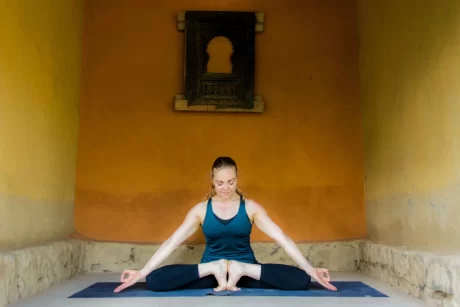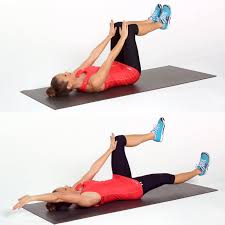Gorakshasana
What is Gorakshasana?
Gorakshasana, also known as the Yogi’s Pose or Cowherd Pose, is a yoga asana (posture) that is derived from the Hatha Yoga tradition. It is named after the great sage Gorakhnath, who was a prominent figure in the Nath tradition of yoga.
This cultural asana is called after the significant Yogi Goraksanath. Yogi Goraksanatha is often seen in this pose. He was the originator of the Nath yoga custom and is said to have utilized this yoga pose for meditation. This posture is consequently practiced by tantric devotees and the Kanphata yogis.
Gorakshasana is a medium-level yoga pose, practiced for various cognitive and health benefits. It is an extremely simple sitting position. To conduct this pose, the practitioner requires a lot of flexibility in the leg muscles. It can execute by any age group individual. Having rehearsed this pose both male and female comfort to maintain celibacy.
How to do Gorakshasana (Yogi Gorakhnath’s Pose)
To begin with, Gorakshasana first of all, you require to seat with your legs outstretched in the facade Or the Dandasana position.
- Now put your feet forward in front of your groin and bring the soles of your feet together.
- Ensure that the soles of both feet are in contact with one another.
- Draw the heels up to the perineum and toes touching the ground.
- After that, while exhaling, put your both hands on the ground floor and press them.
- Then, boost your body and seat on the toes of both feet in such a path that the weight of the body falls right in the middle of the heel.
Try to prolong the knees in such a path that the knees stay on the ground floor. - Next, crossing both your hands, maintain the right heel with the left hand and the left heel with the right hand.
- In this position, straighten your spine, and look state forward or on Nasikagra Drishti.
- Lastly, close your eyes, Focus on breathing, and join your hands in a devotion position or attain any of the gazing Mudras.
Finally, Keep the final pose as long as you feel relaxed.
Gorakshasana Pose Video
Benefits:
- Enhances blood circulation.
- Calm the brain and enhances attention.
- Leg joints and lower back evolve more flexibly.
- Helpful in reducing body fat and toning the body.
- Releases stiffness in hips, calves, and knees.
- It’s an excellent yoga pose meditation and Tantra yoga practice.
- Beneficial in different Kidney ailments, piles, and urinary disorders
- Good pose for enhancing digestion and the overall Digestive system
- Better pose for the Reproductive system and the conservation of Sexual energy
- Redirects to the more high Chakras that aid Kundalini awakening and encourage Muladhara Chakra.
Modification and Props
Newbies can perform Gorakshasana by maintaining the feet in Baddha Konasana, with joined heels. Position them horizontally under the perineum and then sit on the feet.
Against a wall – For providing support and maintaining balance the pose is executed against a wall. Bring the support only from the back while maintaining the asana.
Yoga Blocks – Set the pose blocks vertically in front of you. When you stand on your knees keeping the padmasana you can maintain your feet on the blocks.
Variations
Once the balance is held the joined hands can be extended overhead. This prolongs the spine and makes the pose a small bit additional advanced.
Bhadrasana- In this variation, the feet are joined by getting the heels together near the perineum. The hips are lifted off the ground floor and the practitioner seats on top of the feet. The hands are positioned on the feet.
Contraindications, Precautions
- Sciatica pain
- Knee issues
- Lower back issues
- Hernia Issues in your leg and feet joints.
- Obesity due to intestinal conditions and thyroid.
Conclusion
Rehearsing Gorakshasana is beneficial in multiple paths. In addition to providing the above-mentioned advantages, doing padmasana also makes all of its advantages available. Attempt the posture to boost health advantages in abundance.
FAQ
1. What is the history of Gorakshasana?
Gorakshasana is reached for the sage Gorakhnath, the emergence of the Nath yoga tradition, who is communicated to have utilized the asana for meditation. It is accordingly practiced by his tantric devotees, the Kanphata yogis. It is told to awaken kundalini and halt the procedure of aging.
2. What is Gorakshasana also known as?
Gorakshasana is even named as ‘Goraknath Pose’ or ‘Cowherd Pose’. It is a medium-level yoga posture.
3. What are the limbs of Goraksha Samhita?
Unlike Ashtanga, the eightfold yoga of Patanjali, the text depicts a system of six limbs. Asana, breath control (which is called Pranasamrodha), Pratyahara, Dharana (attention), meditation, and samadhi. Skipping the first two limbs of Ashtanga, namely the yamas, and niyamas.
4. What are the contraindications for Gorakshasana?
Individuals with dizziness, a migraine, or low or high blood pressure even should avoid this posture. Such ailments cause dizziness and this posture can get more additional discomfort or ache if the balance is a challenge.







